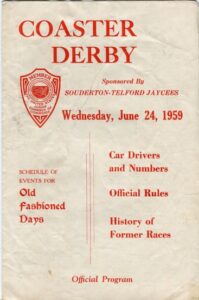
On a summer day in the early 1950s, my younger cousin and I discovered a miniature race car stored under a dusty canvas in our grandfather’s barn on East Broad St., Souderton. After figuring out how to mount the wheels, we rolled the little racer outside for a closer look. Thus began a life long interest in soap box derby racing… eventually shared with my sons and grandson.

In his 1914 silent film debut, Charlie Chaplin starred in ‘Kid Auto Races at Venice’ which played in many theaters nationwide. By 1933 there was so much interest in coaster racing that the first major event was run in Dayton, Ohio where almost 400 youngsters showed up with homemade cars built from soap boxes, orange crates, and tin scraps rolling on wagon or baby buggy wheels. Participation grew rapidly and in 1935 the race was moved to Akron where the All-American Soap Box Derby Association organized to establish rules of fair competition, safety, and to manage the growing sport.
Though coaster racing had already begun in the neighboring town of Perkasie where kids competed from around the area, Souderton’s very first ‘Soap Box Derby’ race was held on August 28, 1941 – after sundown when the stores closed – with some 3000 spectators reported in attendance. Main St. provided an exceptional slope. Many believed it to be one of the fastest in the nation, and to race there was an adventurous experience for any youngster. Though the track was shortened over the years and electronic starting ramps with sophisticated timing devices developed, the race originally began at Summit St. and finished at the fire house, present home of the Montgomery Theater. Except for the overall size and weight of the cars, along with age qualifications for the drivers, rules were few and the cars were built from a wide variety of designs and materials. Uniform wheels and axles supplied by the All American Soap Box Association were required on every car. Among 14 entries, Stanley Albright was declared the inaugural winner while Gerald Rosenberger cracked-up in trial… likely the first victim of the trolley tracks. In 1948, two drivers were hurled into the crowd of spectators lining the street, which would lead to suspension of the annual race until the tracks were permanently removed. Records published in the Souderton Independent confirm the early winners and elapsed times below. Time comparisons may not be entirely objective since exact course distances, ramp height, car construction and racing rules were modified over the years:
1941- Stanley Albright, Souderton Independent- 47 secs.
1942- Robert Delp, N. F. Landis & Sons- 44.75 secs.
1943- Race suspended (WW II)
1944- Richard Hedrick, Hunsicker’s Cut Rate- 43 secs.
1945- Charles Frederick, Hunsicker’s Cut Rate- 44 secs.
1946- Paul Colton, Hunsicker’s Cut Rate- 41 secs.
1947- Frank Beeman, R. E. Hope- 43.2 secs.
1948- Kenneth Bishop, H. A. Goldberg- 43.25 secs.
1949- Joel Moyer, Koffel’s Ice- 37.4 secs.
1950- Joel Moyer, H. A. Goldberg- 35 secs.
1951- Richard Gerhart, H. A. Goldberg-39 secs.
1952- Jay Moyer, H. A. Goldberg- 38 secs.

In 1950 Joel Moyer established an all-time record for the Summit St. start of 35 seconds and his Goldberg car – the very one we had stumbled upon years later in the barn – maintained a dynasty of sorts, winning more races (4) than any car during those budding years. Vivian Snyder, an out of town driver from Slatington and the first notable female driver to race on Main St., turned in the fastest time of the 1951 competition consuming 37.5 seconds to reach the finish line.
Largely for safety reasons, the first decade of the Derby ended after the race in 1952. Years later, after the trolley tracks were removed, several merchants began clamoring for more. Headed by the Souderton-Telford Junior Chamber of Commerce, the races were brought back to life in 1959 as the main event of Old-Fashioned Days… a 4-day celebration held on downtown sidewalks with a parade featuring the high school band, majorettes, fire trucks, and convertibles carrying the Mayor & other local VIPs. Well-known professional racing drivers – Bobby Marshman, Len Duncan, Eddie Schaefer, Lucky Loux, Smitty Smith, & George Dilworth – were seated at the finish line with hometown timekeeper Ted Boyer and Tom ‘Big Daddy’ Donahue, the famed Philadelphia WIBG radio announcer.



A notable piece of racing lore is said to have occurred in 1960 when Susan Farber from Minersville, PA was allegedly clocked at 60 MPH… a considerably faster speed than any car had ever been known to reach on Main St. Some say that she was going so fast that the capture crew missed her as she flew uphill past the Moyer & Son feed mill – now the Old Mill Apartments. Supposedly, Susan rounded the corner onto West Broad St… finally coming to rest on Cowpath Rd. Curiously however, she did not win the race or even place in the contest. Perhaps she failed to return to the starting line for the next heat, unable to continue. James Farber of New Tripoli – the overall winner of the day with the same last name – confirms that he was neither related to Susan nor does he recall her legendary performance.

This second period of Souderton soap box racing ended after the race in 1962 due to the badly deteriorating surface on Main St. In 1970 the races re-emerged on Second St. The Independent reported immense popularity with 39 drivers and 6000 spectators in attendance. However, due to reoccurring accidents – some caused by slotted storm drain covers – races were terminated after 1973.
WINNERS: 1970 – Randy Derstein; 1971 – Roger Jones; 1972 – Joseph Kuhn; 1973 – Dave Guens
… To be continued in the next STHS newsletter as Part 2: 1974 to present…
